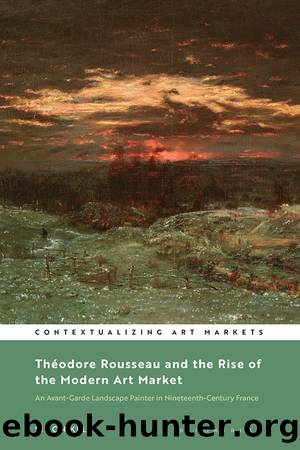Thodore Rousseau and the Rise of the Modern Art Market by Simon Kelly;

Author:Simon Kelly; [Неизв.]
Language: eng
Format: epub
Publisher: Bloomsbury USA
4
The Art Dealers: Adolphe Beugniet to Paul Durand-Ruel
The rise of a dealer network, challenging the traditional Salon system, was crucial to the emergence of the modern art market in France in the nineteenth century. There had been a community of dealers in eighteenth-century France. The space of Gersaintâs gallery, as pictured by Watteau, is perhaps the best-known example. Yet, this network was still relatively limited by the early nineteenth century. An overview of the Paris business directory, the Annuaire Général du Commerce, shows the rapid increase in numbers of art dealers by the middle of the century. There were twenty-three dealers listed in 1827.1 By the late 1850s, that number had more than quadrupled. Not only did dealer numbers increase but so too did their strategies become more ambitious. By the 1860s, the noted dealer Paul Durand-Ruel was using a wide range of approaches. Recent scholarship on Durand-Ruelâs career, building on the writing of Linda Whiteley, has highlighted the significance of his innovative methods in promoting not only the Impressionists but also what the dealer called the âbeautiful School of 1830.â2 Among these were the monopolization of the artists in his stable, the consistent setting of sale records for their work at auction, the spectacular one-person retrospective, the artist biography to raise collector interest and further legitimize his artistsâ work, and the promotion of work not only in France but through an international gallery network across Europe and America. All of these strategies anticipate modern dealing methods and Durand-Ruel was certainly a leading figure in developing them. Yet, he was not necessarily unique in his practices. The Belgian dealer Gustave CouÌteaux, for example, explored some similar methodsânotably monopolization of his artistsâfrom the 1840s.3 The loss of the archives of other Parisian mid-nineteenth-century dealers has also deprived us of knowledge of the practices of many other of Durand-Ruelâs contemporaries.
Within this context of the increasing power of art dealers in the French art world, artists too developed strategies to express their own agency. They constructed networks of several dealers, playing off one against the other in order to achieve higher prices. They produced small- to mid-scale work consciously aimed at dealer galleries that were smaller than the grand spaces of the Salon. Such works also fitted well in gallery windows within a growing culture of display and spectacle in mid-century Paris. Artists also offered discounts in return for buying work in bulk. Eugène Delacroix sold pictures to an extensive network of Parisian dealers in the 1840s and 1850s.4 So too did Corot and Courbet.5 Artists did not generally produce work for a single dealer. Charles-François Daubigny sold his paintings to the very large number of thirty-eight different dealers.6 Théodore Rousseau, for his part, would come to immerse himself in the world of Parisian dealers during the prosperous years of the Second Empire.
Early Years
The young group of innovative landscape painters or âSchool of 1830â who emerged in Paris in the early 1830s succeeded in finding a network of dealer support. Dupré consistently sold
Download
This site does not store any files on its server. We only index and link to content provided by other sites. Please contact the content providers to delete copyright contents if any and email us, we'll remove relevant links or contents immediately.
The Japanese Porn Industry Unmasked - An Insider's Guide by Kaho Shibuya(738)
A Whore's Manifesto by Kay Kassirer(709)
Morpho: Clothing Folds and Creases by Michel Lauricella(672)
Morpho: Skeleton and Bone Reference Points by Michel Lauricella(651)
Food Anatomy: The Curious Parts & Pieces of Our Edible World (Julia Rothman) by Julia Rothman(633)
Morpho: Muscled Bodies by Michel Lauricella(597)
Beginner's Guide to Fantasy Drawing by 3dtotal Publishing(586)
How to Draw: Learn to Draw Anything in an Easy and Fun Way with Chiaroscuro, Hatching, Sketching and other Techniques, from Beginner to Advanced by Papa Alfredo(554)
ImagineFX presents How To Draw & Paint Anatomy, Vol 2 by Unknown(514)
Figure Drawing by Jake Spicer(506)
Anatomy for Artists: Drawing Form & Pose: The Ultimate Guide to Drawing Anatomy in Perspective and Pose by Tomfoxdraws(495)
Morpho: Simplified Forms: Anatomy for Artists by Michel Lauricella(493)
The Severed Head by Julia Kristeva(485)
Creative Portraits in Watercolor (for True Epub) by Ana Santos(464)
Morpho: Hands and Feet: Anatomy for Artists by Michel Lauricella(453)
Watercolor Your Way (for Dominick Dunkin) by Sarah Cray(448)
Art of the Buckle by Jim Arndt & Mary Emmerling(433)
Essential Human Anatomy for Artists by Goldman Ken;(419)
Interpassivity: The Aesthetics of Delegated Enjoyment by Robert Pfaller(391)
